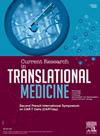VEXAS综合征的感染:文献的系统回顾
IF 3
4区 医学
Q2 MEDICINE, RESEARCH & EXPERIMENTAL
引用次数: 0
摘要
空泡化,E1酶,x -连锁,自身炎症,躯体(VEXAS)综合征是一种多系统疾病,需要慢性免疫抑制。机会性感染很常见;然而,没有明确的预防方案。对文献进行了系统的回顾。对6篇发表的123例患者进行了评估。86例有人口统计学资料的患者;多数为男性(85例,98.8%),中位年龄73岁。80例患者报告了UBA1突变状态:p.Met41Thr (n = 43, 53.8%)、p.Met41Val (n = 17, 21.3%)和p.Met41Leu (n = 12, 15.0%)最为常见。在这些患者中,48例(60%)有潜在的骨髓增生异常综合征。许多患者多次住院治疗。报告感染病例如下:covid - 19 (n = 20)、吉罗氏肺囊虫肺炎(n = 16)、非结核分枝杆菌(NTM) (n = 16)、肠杆菌科(n = 14)、军团菌(n = 13)、水痘带状疱疹病毒(n = 11)和单纯疱疹病毒(n = 8)感染。每日强的松龙剂量等于或大于10mg,总体中位长期类固醇治疗持续时间为3.1年。值得注意的是,对于NTM,泼尼松龙的中位每日剂量为12.5 mg。强的松龙治疗PJP的中位剂量仅在一篇出版物中报道,包括6名患者,每天17毫克。在可获得数据的地方,95例患者中有45例(47.3%)在最后随访时死亡。在45例死亡中,32例(71.1%)是由于并发感染。总之,机会性感染通常在VEXAS综合征中报道。预防此类感染仍然是最重要的,但在建议上没有明确的共识,这突出了前瞻性研究的必要性。此外,进一步了解VEXAS综合征的病理生理学和先天免疫和体液免疫的损害可能会澄清它在高背景免疫抑制治疗之外对感染的贡献。本文章由计算机程序翻译,如有差异,请以英文原文为准。
Infections in VEXAS syndrome: a systematic review of the literature
Vacuolation, E1 enzyme, X-linked, autoinflammatory, somatic (VEXAS) syndrome is a multisystem disease for which chronic immunosuppression is needed. Opportunistic infections are common; however, a clear prophylaxis regimen is not defined.
A systematic review of the literature was undertaken. Six publications with 123 patients were evaluated. Of 86 patients with demographic data; most were males (n = 85, 98.8 %) and median age was 73 years. UBA1 mutational status was reported in 80 patients: p.Met41Thr (n = 43, 53.8 %), p.Met41Val (n = 17, 21.3 %) and p.Met41Leu (n = 12, 15.0 %) were most common. In these patients, 48 (60 %) had underlying myelodysplastic syndrome.
Many of the patients had multiple hospitalizations. Infections were reported as follows: COVID19 (n = 20), Pneumocystis jiroveci pneumonia (PJP) (n = 16), nontuberculous mycobacterium (NTM) species (n = 16), Enterobacteriaceae species (n = 14), Legionella species (n = 13), Varicella Zoster virus (n = 11) and Herpes Simplex Virus (n = 8) infections, respectively.
Daily prednisolone dose was at, or greater than 10 mg and overall median long term steroid treatment duration was 3.1 years. Notably, for NTM the median daily prednisolone dose was 12.5 mg. Median prednisolone dosing for PJP was only reported in one of the publications, comprising six patients, at 17 mg per day. Where data was available, 45 of the 95 patients (47.3 %) were deceased at last follow-up. Of the 45 deaths, 32 (71.1 %) were attributed to the intercurrent infection.
In summary, opportunistic infections are commonly reported in VEXAS syndrome. Prophylaxis for such infections remains paramount but no clear consensus on recommendations exists, highlighting the need for prospective studies. Moreover, furthering our understanding of pathophysiology of VEXAS syndrome and impairment in both innate and humoral immunity may clarify its contribution to infections in addition to high background immunosuppressive therapies.
求助全文
通过发布文献求助,成功后即可免费获取论文全文。
去求助
来源期刊

Current Research in Translational Medicine
Biochemistry, Genetics and Molecular Biology-General Biochemistry,Genetics and Molecular Biology
CiteScore
7.00
自引率
4.90%
发文量
51
审稿时长
45 days
期刊介绍:
Current Research in Translational Medicine is a peer-reviewed journal, publishing worldwide clinical and basic research in the field of hematology, immunology, infectiology, hematopoietic cell transplantation, and cellular and gene therapy. The journal considers for publication English-language editorials, original articles, reviews, and short reports including case-reports. Contributions are intended to draw attention to experimental medicine and translational research. Current Research in Translational Medicine periodically publishes thematic issues and is indexed in all major international databases (2017 Impact Factor is 1.9).
Core areas covered in Current Research in Translational Medicine are:
Hematology,
Immunology,
Infectiology,
Hematopoietic,
Cell Transplantation,
Cellular and Gene Therapy.
 求助内容:
求助内容: 应助结果提醒方式:
应助结果提醒方式:


